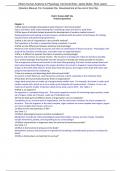(Hole's Human Anatomy & Physiology 14e David Shier, Jackie Butler, Ricki Lewis)
(Solution Manual, For Complete File, Download link at the end of this File)
Hole’s Human A&P 14e
Practice Questions
Chapter 1
1 What factors probably stimulated an early interest in the human body?
Injury and illness, both understanding their underlying causes and how to treat them.
2 What types of activities helped promote the development of modern medical science?
Asking questions and seeking accurate answers, combined with the advent of techniques for making
measurements and performing experiments.
3 What is the role of a hypothesis in the scientific method?
The hypothesis is the idea or proposition being evaluated, or tested.
4 What are the differences between anatomy and physiology?
Anatomy is the study of body structures and relies on examination of those structures. Physiology is the
study of the functions of body parts, and relies more on experimentation.
5 Why is it difficult to separate the topics of anatomy and physiology?
Structure and function are closely related. The structure of a body part makes its functions possible.
6 List several examples that illustrate how the structure of a body part makes possible its function.
The arrangement of bones and muscles in the hand allow grasping; the heart muscle pumps blood and
heart valves keep blood flowing in the proper direction; the mouth is shaped to receive food and the
shapes of the teeth allow them to break down food into pieces; the tongue mixes food with saliva and
prepares food particles for swallowing.
7 How are anatomy and physiology both old and new fields?
As ancient as both fields are, new discoveries continue in both, especially at the molecular level.
8 How does the human body illustrate levels of organization?
Larger body structures are made up of progressively smaller ones. For example, the heart is made up of
cardiac muscle cells, which are in turn made up of molecules of muscle protein. Proteins, in turn, are
made up of specific smaller molecules called amino acids, and so forth. See Table 1.1
9 What is an organism?
An organism is a complete living unit. The human organism consists of interacting organ systems, made
up of organs, made up of tissues, made up of individual cells.
10 How do body parts at different levels of organization vary in complexity?
Complexity occurs at every level of organization, but the more parts involved, the more complex the
structure. Thus the organism is the most complex, organ systems are more complex than organs, organs
are more complex than tissues, and so on.
11 What are the characteristics of life?
See Table 1.2
12 Which physiological events constitute metabolism?
Metabolism includes all of the physiological events that obtain, release, and use energy. Examples
include movement, growth, and responding to our surroundings?
13 Which requirements of organisms does the external environment provide?
See Table 1.3
14 What is the function of pressure in the body?
Atmospheric pressure (air pressure) is important for breathing, and hydrostatic pressure circulates the
blood.
15 Why is homeostasis so important to survival?
, Survival of the human organism depends on the survival of its cells. Homeostasis maintains the internal
environment, in which those cells live.
16 Describe three homeostatic mechanisms.
Sweating and skin blood flow increase if body temperature rises above the set point. Sweating and skin
blood flow decrease, and shivering may occur, if the body temperature falls below the set point. Blood
glucose is regulated by the hormones insulin and glucagon.
17 What are the viscera?
Viscera are the organs within the thoracic and abdominopelvic cavities.
18 Which organs occupy the thoracic cavity?
Heart, lungs, trachea, esophagus, thymus
The abdominal cavity?
Stomach, liver, spleen, gallbladder, kidneys, small intestine, large intestine
The pelvic cavity?
Terminal end of the large intestine, urinary bladder, internal reproductive organs
19 Name the cavities of the head.
Cranial cavity, oral cavity, nasal cavity, orbital cavities, middle ear cavities
20 Describe the membranes associated with the thoracic cavity.
Serous membranes are associated with organs in the thoracic cavity, including the two visceral pleural
membranes (on the surface of the lungs) and the visceral pericardium (on the surface of the heart.)
Serous membranes are also associated with the wall of the cavity, including the parietal pleurae, the
parietal pericardium, and the fibrous pericardium.
21 Distinguish between the parietal and visceral peritoneum.
The parietal peritoneum lines the inner surface of the wall of the abdominal cavity, and the visceral
peritoneum covers the surfaces of the abdominal organs.
22 Name the major organ systems and list the organs of each system.
See Table 1.4
23 Describe the general functions of each organ system.
See Table 1.4
24 Define aging.
Aging refers to the changes in the body that occur with the passage of time.
25 List some aging-related changes at the microscopic and whole-body levels.
Microscopic include: decreased production of elastin and collagen proteins, diminished subcutaneous
fat lead to skin wrinkling; increased percentage of body fat alters drug metabolism; DNA repair
mechanisms become less efficient, as does energy extraction from nutrients. Whole body includes:
fading hair color, wrinkling skin, less effective immune system, increased blood pressure and slightly
elevated blood glucose that may become clinically significant.
26 Describe the anatomical position.
Standing erect, face forward, upper limbs at the sides, palms forward
27 Using the appropriate terms, describe the relative positions of several body parts.
See figure 1.21
28 Describe three types of body sections.
See figures 1.22 and 1.23
29 Describe the nine regions of the abdomen.
See figure 1.25(a)
30 Explain how the names of the abdominal quadrants describe their locations.




